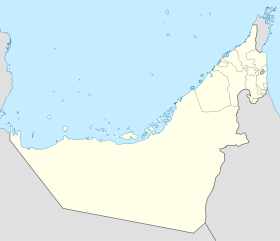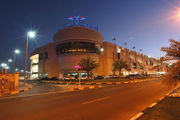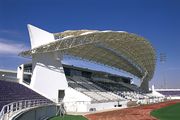Al Ain
| Al Ain العين |
|||
|---|---|---|---|
| — town — | |||
| Al Ain | |||
 |
|||
|
|||
 Al Ain
|
|||
| Coordinates: | |||
| Country | United Arab Emirates | ||
| Emirate | Abu Dhabi | ||
| Subdivisions | |||
| Government | |||
| - Type | Constitutional monarchy | ||
| - Sheikh | Khalifa bin Zayed Al Nahyan | ||
| - Crown Prince | Mohammed Bin Zayed Bin Sultan Al Nahyan | ||
| Population (2009) | |||
| - Total | 374,000 | ||
| Time zone | UAE Standard Time (UTC+4) | ||
Al Ain (Arabic: العين, al-ʿayn, literally The Spring), also known as the Garden City due to its greenery, is the second largest city in the Abu Dhabi Emirate and the fourth largest city in the United Arab Emirates. With a population of 374,000[1] (2009), it is located approximately 160 km east of the capital Abu Dhabi and about 120 km south of Dubai. Al Ain is the birthplace of Sheikh Zayed bin Sultan Al Nahyan, the first president of the United Arab Emirates, and it has the country's highest number of Emirati nationals.
Al Ain is located in Abu Dhabi, inland on the border with Oman. The freeways connecting Al Ain, Abu Dhabi and Dubai form a geographic triangle in the center of the country, each city being roughly 130 kilometers from the other two.
Contents |
History
Historically the area was known as Tawam, Al Buraimi oasis and Al Ain, which means "the water spring". Al Ain has been continuously inhabited for more than four thousand years and is considered central to the cultural heritage of the country. It is the birthplace of Shaikh Zayed bin Sultan Al Nahyan, the first president of the United Arab Emirates. Today, the name Buraimi refers to the Omani town whose urban area merges with that of Al Ain. Until late in 2006, Al Ain and Buraimi enjoyed an open border and functioned as a unit. Then on September 14 of that year, the UAE government closed the open border and required all individuals to clear immigration whether entering or leaving the UAE. While arab nationals of the Persian Gulf may cross the border at the main crossing, expats must cross at either the Hili or "Intercontinental" border crossings. The area's numerous underground water springs explain its attractiveness for settlement. Traces remain of its traditional past, including camel racing and camel breeding. The ancient falaj system of irrigation is still in use in some areas; this system distributes underground water by a network of tunnels which emerge eventually into open channels whose flow can be directed and regulated.
Geography
Al Ain is located in the Eastern region of Abu Dhabi Emirate just south of Dubai and east of Abu Dhabi. The Eastern region covers an area of approximately 13,100 km². Oman lies to the east, Dubai and Sharjah to the north, Abu Dhabi to the west and the Empty Quarter desert and Saudi Arabia to the south. The topography of Al Ain is unique and varies as you travel to the east. Jebel Hafeet (Hafeet mountain) is considered one of the monuments of Al Ain, lying just to the southeast and rising to 1,300 meters in elevation. Sand dunes of varying texture that are tinged red with iron oxide lie to the north and east of Al Ain.
Weather
In Al Ain, the mean annual rainfall is 96 mm and the average relative humidity is 60% (United Arab Emirates University, 1993). Low humidity in Al Ain, particularly during the summers, makes it a popular destination for many people at that time of year. Boer (1997) classified the UAE climate as hyper-arid and divided it into four climatic regions: the coastal zone along the Persian Gulf, the mountain areas northeast of UAE, the gravel plains around Al Ain area, and the central and southern sand desert. More rainfall and lower temperatures occur in the northeast than in the southern and western regions. The monthly average rainfall around Al Ain was (100–120 mm) from the period 1970 to 1992.
Present-Day Al Ain

Al Ain has a higher proportion of Emirati nationals than elsewhere in the country, but the majority of its residents are expatriates particularly from the Indian sub-continent. Many people are from Pakistan. There are fewer other expatriates than in the larger centers of Abu Dhabi and Dubai.
Al Ain is often called the 'Garden City of The Gulf' given the many oases, parks, tree-lined avenues and decorative roundabouts within the city. Strict height controls on new buildings, to no more than seven floors, emphasise the greenery of the city.
The city is known for its relatively empty roads; this is a growing concern, however, as the population is increasing and the roads have not been able to accommodate the excess traffic
Tourism & Recreation
Al Ain is developing as a tourist destination. It regularly records the highest summer temperatures in the country, but the dry desert air makes it a welcome retreat from the coastal humidity of the larger cities. Many Emirati nationals in Abu Dhabi have holiday houses in the city making it a popular weekend destination for families from the capital city. Its attractions include the Al Ain National Museum, the Al Ain Palace Museum, several restored forts and the Hili archaeological site, dating back to the Bronze Age. Jebel Hafeet, a 1340-metre-high mountain, dominates the surrounding area. It is popular to visit to the mineral springs at the base and to drive to the mountaintop at sunset. Other attractions include the Al Ain Oasis in the city centre, other oases dotted around the area - all cool retreats in the middle of the summer heat - a zoo, an amusement park named "Al Ain Fun City", many well-maintained parks popular with families in the summer evenings, and a heritage village.
Al Ain has three major malls - Al Ain Mall in town center, Al-Jimi Mall in the Al-Jimi district, and Bawadi Mall located in the Defense District. Most commercial activity is centered in and around town center.
The city is home to the successful association football (soccer) club, Al Ain Club.
Another popular pastime for Emiratis and expatriates alike is spending time in coffee shops and Shisha Cafes. There are many cafes in Al Ain, ranging in size and quality.
Al Ain can also boast an International standard Go-Kart circuit. Al Ain Raceway was selected to host the 2007 Rotax Max World Karting Finals, an event which saw 220 drivers from over 55 different countries compete for the Karting world title. Al Ain Raceway opened to the general public in May 2008 and proves a popular activity for local Emiratis and tourists alike.
Like the rest of the UAE, Al Ain has strict laws governing the consumption and distribution of alcohol. Four facilities in the city currently serve alcohol, three of which are hotels. The Al Ain Rotana, Hilton, and Intercontinental Hotels all have pubs, bars, or night clubs. In addition to the hotels, the Al Ain Palms Sports Resort in Al-Maqam also serves alcohol.
Currently, there are only three locations that sell alcohol for private use - Spinny's near the Al-Jimi district, the Hilton hotel, and the North Africa Market in Sanaiya.
The city has three English-speaking radio stations - 95.6 FM, which plays the top 100 hits without commercials, 100.1 Star FM, which plays English-speaking hits alternating with Arabic-speaking hits, and 105.7 Abu Dhabi Classic FM, which plays classical music.
Oases

It is known for its underground irrigation system "falaj" which brings water from boreholes to water farms and palm trees. Falaj irrigation is an ancient system dating back thousands of years and is used widely in Oman, UAE, China, Iran and many other countries. Al Ain has 7 oases; the largest is Al Ain Oasis, just south of the town center, and the smallest is Al Jahili Oasis. The rest are Qattara, Al Mutaredh, Al Jimi, Al Muaiji, and Hili.
Commerce and Industry
Al Ain is an important services center for a wide area extending into Oman. There are three major shopping centers, Al Ain Mall, Al Jimi Mall and Al Bawadi Mall (opened in 2009 in the Mezyad area) as well as traditional souks for fruit & vegetables and livestock. Industry is growing, but is still on a small scale, and includes the Coca Cola bottling plant and the Al Ain Portland Cement Works. Service industries such as car sales, mechanics and other artisans are located in the area known as Sanaiya. Social and governmental infrastructure includes United Arab Emirates University, Higher Colleges of Technology, Abu Dhabi University (Al Ain campus), well-equipped medical facilities including the teaching hospital at Tawam, military training areas and Al Ain International Airport.
Education
Al Ain is home to the main university in the UAE, The United Arab Emirates University and two campuses of the Higher Colleges of Technology. Privately-owned higher education institutions include the Al Ain University of Science and Technology and Abu Dhabi University (Al Ain campus). Many of Al Ain's private schools, catering mainly to the expatriate population, are located in the Al Manseer area. These include a branch of the International School of Choueifat, Al Dhafra Private School, Liwa International School, the Pakistan Islamia Higher Secondary School, Emirates Private School, Institute of Applied Technology, and the Al Ain English Speaking School. Other private schools include Al Ain Juniors School. CBSE affiliated schools include Indian School Al Ain, which usually tops in results.
Health
The first hospital in Al Ain was Oasis Hospital, established in 1960 at the invitation of Sheikh Zayed. Oasis serves all nationalities, and provides training for medical students from UAE University. Ground has been broken for a new hospital to be completed in 2011. Oasis Hospital is part of CURE International.
Al Ain is the home of Tawam Hospital, a training and research hospital linked with the UAE University. It was officially inaugurated on 17 December 1979. In March 2006, Johns Hopkins Hospital (Johns Hopkins Medicine International) (JHMI) took over the management of Tawam hospital.
Al Ain Hospital (abbr: AAH, also known as Al Jimi Hospital) is the general hospital delivering health services to all Al-Ain patients regardless of their nationality. It is centrally located in the Al Jimi district and is linked with the UAE University. Al Ain Hospital still occupies old 1970s buildings, but a new building is planned. AAH currently has about 450 beds and provides services in all medical disciplines. In September 2007, the Medical University of Vienna International [1] (MUVI) took over the management of AAH.
Sport, Culture and the Arts

Al Ain is a cultural retreat for residents of Dubai and Abu Dhabi cities. It is home to a major festival of classical music.
Al Ain City is the home of Al Ain Club, which is one of the most successful football clubs in the UAE and Asia. It has many titles and championships under its belt.
Future Development Plans
Al Qudra Holdings, working in partnership with QP International, announced in 2007 two major masterplans for Al Ain - Ain al Emarat and Ain al Fayda.[2]
When completed in 2022, Ain al Emarat will be able to house an additional 115,000 people in Al Ain. It is said to offer a living and working, low rise, low impact, ecologically-aware alternative to Abu Dhabi and Dubai. At the heart of the city is a genre aimed at fostering healthy, natural lifestyles linking the community with the surrounding low-density green environment. It is a large-scale ambitious scheme, located on the northeast outskirts of the existing Al Ain city. The plans include cultural and leisure amenities which will be integrated with the fabric of the city, encouraging social interaction, community spirit and wholesome lifestyles. A multi-purpose dome with a 40,000 seat enclosed stadium will create a sporting focus on the 900 hectare site. Extensive canals and waterways will link the city's residential areas, academic departments, health facilities, schools and the sports/football academy. All buildings will be adapted to work efficiently in the desert environment, with extensive solar shading and use of appropriate material for the desert location. When completed, the development will contain 30,000 apartments, 3,500 residential villas, 800,000 m² retail and leisure facilities and 1.5 million m² office space as well as religious and public health amenities.
Ain al Fayda, due for completion in 2018, will be located south of the existing city, at the foot of Jebel Hafeet. Along with Ain al Emarat, this forms one of the largest urban developments in the GCC. In keeping with the theme of the existing hot springs of Ain al Fayda, this new development of the 'healing oasis' is set to deliver a complete spectrum of health treatment, filling a gap in the market in this region. It will provide hotels, spas and wellness facilities, residential, entertainment and leisure options including a waterpark, lakes and canals. It will allow residents and visitors to find equilibrium in a surrounding that is in perfect harmony with nature and the local culture.
References
External links
- Al-Ain Expat
- Al Ain Living
- Al Ain Municipality
- Al Ain Portal
- Tawam Hospital
- Al Ain National Museum
- Al Ain Football Club
- Al Ain: Oasis in the Desert (Photographic essay from Al Ain Women's College)
- Al Ain Times
- Al Ain Mall
- Al Ain University of Science and Technology
- Abu Dhabi University
- QP International
|
|||||||||||||||||||||||
